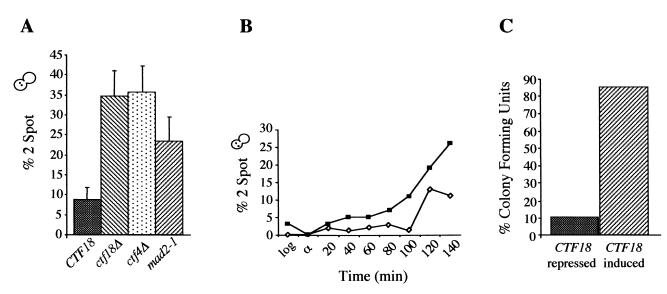FIG. 2.
CTF4 and CTF18 are required for sister chromatid cohesion. (A) Early-log-phase cultures were treated to induce GFP-LacI expression, incubated for 3 h in rYPD containing nocodazole, and fixed in paraformaldehyde. For each strain, 100 cells exhibiting GFP fluorescence were scored within each experiment. The histogram shows the mean and standard deviation for a minimum of three trials. Strains were CTF18 (AFS173), ctf18Δ (YJH17.2), ctf4Δ (YJH37), and mad2-1 (AFS387). Note that approximately 5% of ctf4Δ or ctf18Δ cells have >1 chromosome III as determined during G1 arrest. (B) Kinetics of sister chromatid separation in ctf18Δ mutants. Log-phase cultures were arrested in α-factor and released into rYPD-nocodazole. After α-factor release, both strains sychronously completed S phase at 60 min postrelease as determined by flow cytometry (data not shown). YJH17.2 data were normalized using the α-factor arrest time point, to remove the contribution of cells containing >1 copy of chromosome III. A total of 100 informative cells were counted at each time point. (C) A ctf18Δ strain containing GAL-CTF18 on a plasmid (YJH48) was grown in selective medium containing either galactose or glucose. Log-phase cells were then shifted to rYPD-nocadozole for 4 h and then plated onto SC-URA glucose medium. CFU were counted after 24 h. The experiment was performed twice with similar results (mean values are shown).

